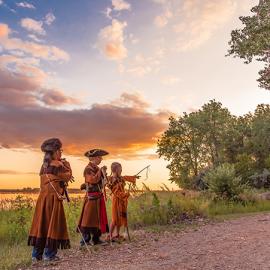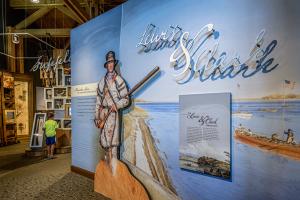
Exploring the Lewis and Clark Trail
Explorers Lewis and Clark were among the earliest visitors to North Dakota. They mapped out a trail for you to follow through North Dakota.

The site marks the original burial ground of Hunkpapa Sioux leader Sitting bull, who was killed on Dec. 15, 1890. Sitting Bull was known for his dreams of a soldier falling down in camp, representing the defeat of General George Custer on June 25, 1876, at the Little Bighorn.

The visitor center on the National Native American Scenic Byway contains photos and artifacts from the Standing Rock Sioux Tribe's past.

Fort Abraham Lincoln was once an important infantry and cavalry post. It was from this fort that Lt. Col. George Armstrong Custer and the Seventh cavalry rode out on their ill-fated expedition against the Sioux at the Little Big Horn. Portions of the military post, including the Custer House, have been reconstructed.

On-A-Slant Indian Village on the grounds of Fort Abraham Lincoln State Park features reconstructed earthlodges depicting the lifestyle of the Mandan Indians, who occupied this site from about 1575-1781.

Take a self-guided or guided tour of the 19-story, Art Deco capitol building constructed in 1933 for $2 million. It contains unique woods and materials from many states and countries. There are two parks, Capitol Park and the Myron Atkinson Park as well as designated walking routes on the Capitol Complex grounds that vary from one-quarter mile up to a full mile loop.

Experience the beauty and wonder of the new galleries and exhibit spaces at the State Museum at the North Dakota Heritage Center. Thousands of artifacts and specimens, high-tech displays, and interactive exhibits help tell the story of our state.

Cruise the majestic Missouri River on the Lewis and Clark Riverboat. Try a regular excursion or if you enjoy a bit of elegance in your life, try their special dinner cruise. There is something for everyone at the Lewis and Clark Riverboat.

Double Ditch Indian Village was a large earthlodge village inhabited by the Mandan Indians for nearly 300 years (AD 1490-1785). According to Mandan oral history, the population in this area totaled approximately 10,000 or more during this time. A massive smallpox epidemic was apparently responsible for the abandonment of Double Ditch and all the other Mandan villages near the Heart River.

Newly-installed exhibits at the Lewis and Clark Interpretive Center will immerse you in the journey of the Lewis & Clark Expedition with sounds and interactive displays. The exhibits include over 100 items from the John Fisher Collection that represent items Lewis & Clark used on the expedition, including one of only six working air rifles in the world.

Take a step back in time when you visit the reconstructed Fort Mandan, the winter home of the Lewis & Clark Expedition from 1804-1805. The fully-furnished quarters bring to life what it was like for the brave men in the Corps of Discovery during the winter over 200 years ago.

Native Americans occupied this area for more than 11,000 years. There are remains of three Hidatsa villages with 210 depressions at the site. Home of Sakakawea, a modern museum, visitor center and movies.

Garrison Dam forms Lake Sakakawea on the Missouri River. It is the third-largest reservoir in the nation. Visit their website for more information on tours of the power plant and other displays.

Museum exhibits and interpretive walking trail tell the stories of the area around the confluence of the Missouri and Yellowstone rivers.

Fort Buford was built in 1866 near the confluence of the Missouri and Yellowstone rivers, and became a major supply depot for military field operations. While it served an essential role as the sentinel on the Northern Plains for 29 years, it is probably best remembered as the place where famous Hunkpapa Sioux leader Sitting Bull surrendered in 1881.

The principal fur trading post of the American Fur Company on the upper Missouri River served Assiniboine, Crow, Cree, Ojibway, Hidatsa, more than 25,000 buffalo robes, and $100,000 in merchandise.